TPMS MAZDA MODEL CX-9 2017 Owners Manual (in English)
[x] Cancel search | Manufacturer: MAZDA, Model Year: 2017, Model line: MODEL CX-9, Model: MAZDA MODEL CX-9 2017Pages: 612
Page 298 of 612
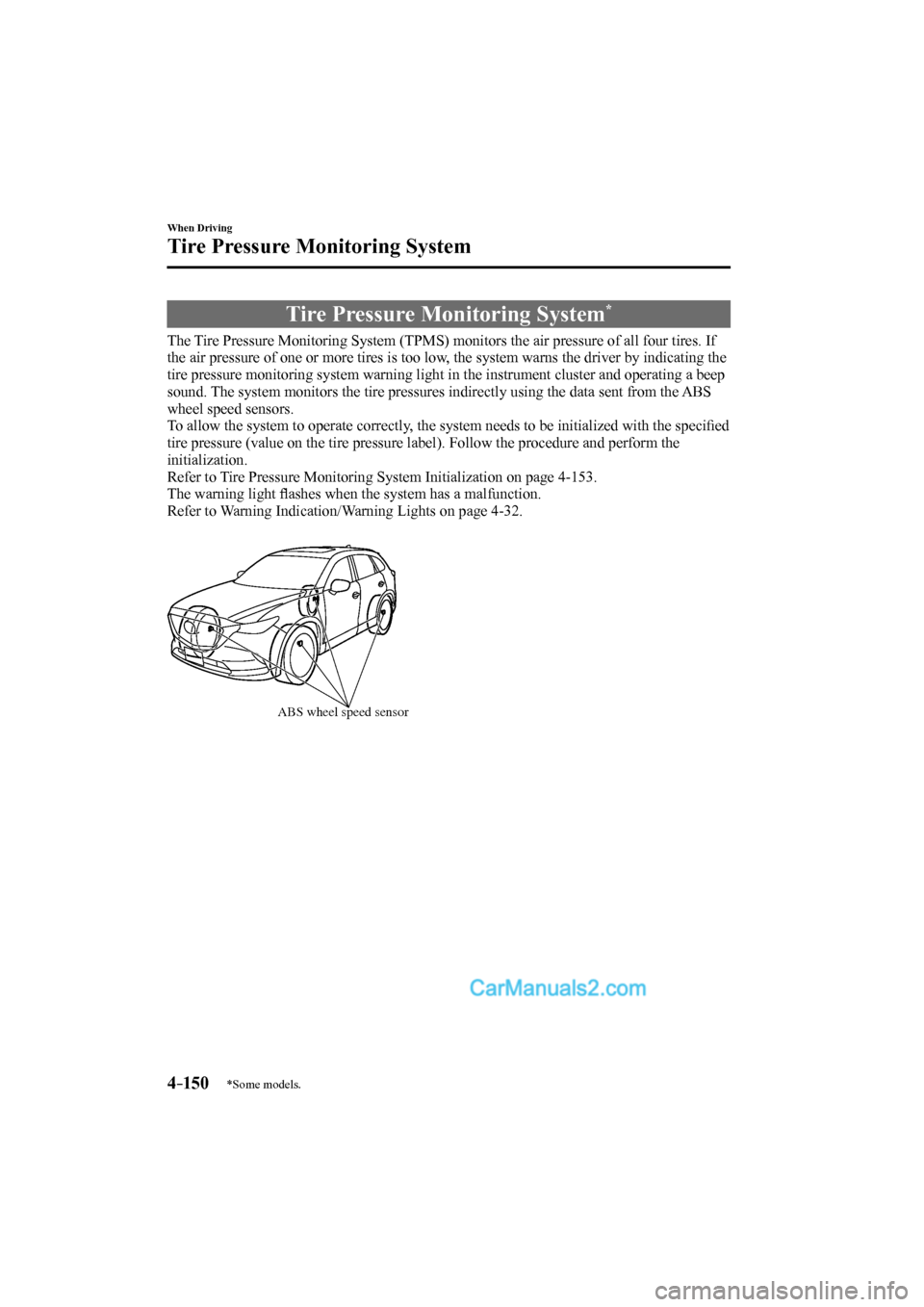
4–150
When Driving
Tire Pressure Monitoring System
*Some models.
Tire Pressure Monitoring System *
The Tire Pressure Monitoring System (TPMS) monitors the air pressure of all four tires. If
the air pressure of one or more tires is too low, the system warns the driver by indicating the
tire pressure monitoring system warning light in the instrument cluster and operating a beep
sound. The system monitors the tire pressures indirectly using the data sent from the ABS
wheel speed sensors.
To allow the system to operate correctly, the system needs to be initialized with the specifi ed
tire pressure (value on the tire pressure label). Follow the procedure and perform the
initialization.
Refer to Tire Pressure Monitoring System Initialization on page 4-153 .
The warning light fl ashes when the system has a malfunction.
Refer to Warning Indication/Warning Lights on page 4-32 .
ABS wheel speed sensor
CX-9_8FS7-EA-16K_Edition2.indb 150CX-9_8FS7-EA-16K_Edition2.indb 1502016/12/15 18:34:412016/12/15 18:34:41
Page 299 of 612
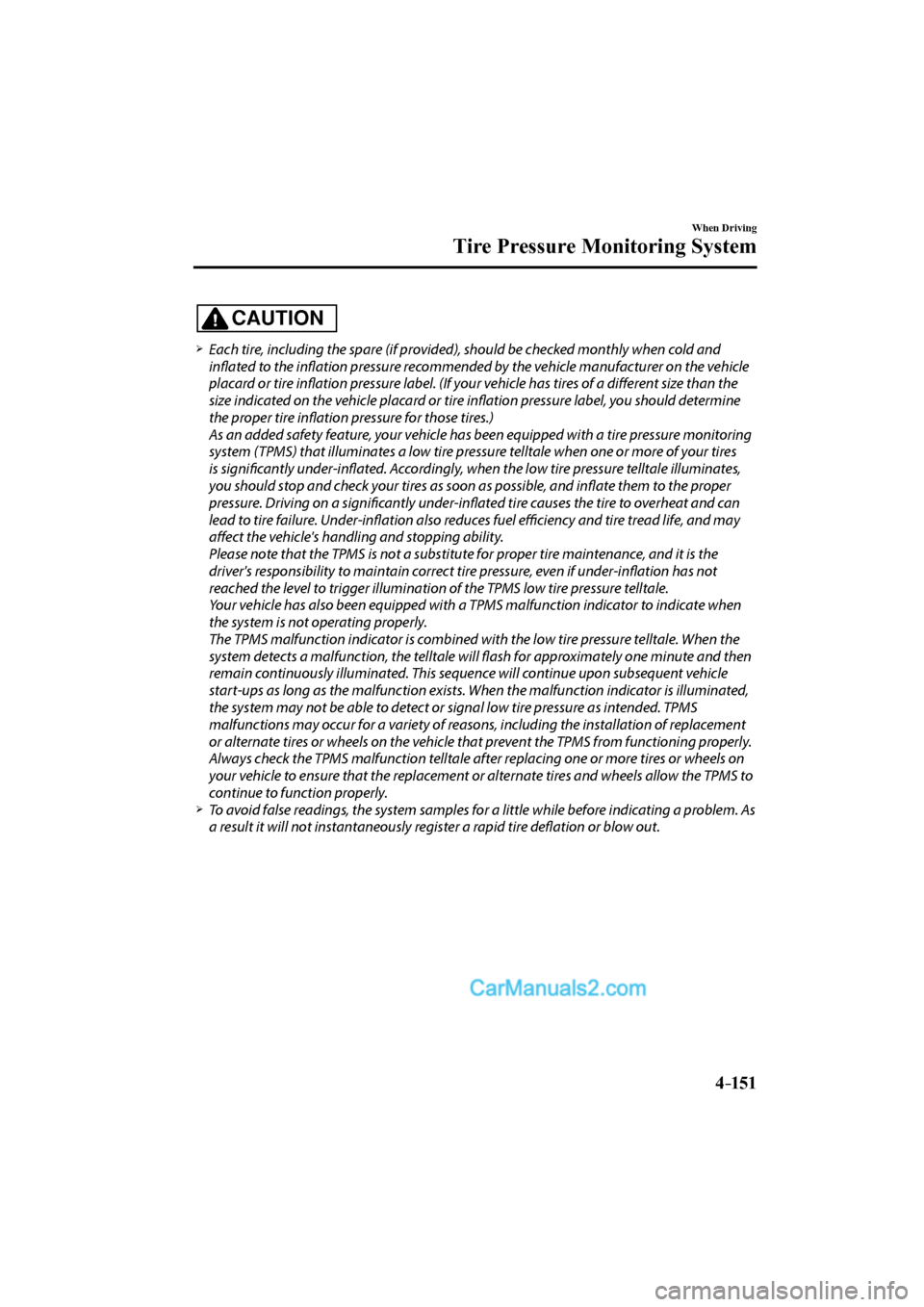
4–151
When Driving
Tire Pressure Monitoring System
CAUTION
Each tire, including the spare (if provided), should be checked monthly when cold and
infl ated to the infl ation pressure recommended by the vehicle manufacturer on the vehicle
placard or tire infl ation pressure label. (If your vehicle has tires of a diff erent size than the
size indicated on the vehicle placard or tire infl ation pressure label, you should determine
the proper tire infl ation pressure for those tires.)
As an added safety feature, your vehicle has been equipped with a tire pressure monitoring
system (TPMS) that illuminates a low tire pressure telltale when one or more of your tires
is signifi cantly under-infl ated. Accordingly, when the low tire pressure telltale illuminates,
you should stop and check your tires as soon as possible, and infl ate them to the proper
pressure. Driving on a signifi cantly under-infl ated tire causes the tire to overheat and can
lead to tire failure. Under-infl ation also reduces fuel effi ciency and tire tread life, and may
aff ect the vehicle's handling and stopping ability.
Please note that the TPMS is not a substitute for proper tire maintenance, and it is the
driver's responsibility to maintain correct tire pressure, even if under-infl ation has not
reached the level to trigger illumination of the TPMS low tire pressure telltale.
Your vehicle has also been equipped with a TPMS malfunction indicator to indicate when
the system is not operating properly.
The TPMS malfunction indicator is combined with the low tire pressure telltale. When the
system detects a malfunction, the telltale will fl ash for approximately one minute and then
remain continuously illuminated. This sequence will continue upon subsequent vehicle
start-ups as long as the malfunction exists. When the malfunction indicator is illuminated,
the system may not be able to detect or signal low tire pressure as intended. TPMS
malfunctions may occur for a variety of reasons, including the installation of replacement
or alternate tires or wheels on the vehicle that prevent the TPMS from functioning properly.
Always check the TPMS malfunction telltale after replacing one or more tires or wheels on
your vehicle to ensure that the replacement or alternate tires and wheels allow the TPMS to
continue to function properly.
To avoid false readings, the system samples for a little while before indicating a problem. As
a result it will not instantaneously register a rapid tire defl ation or blow out.
CX-9_8FS7-EA-16K_Edition2.indb 151CX-9_8FS7-EA-16K_Edition2.indb 1512016/12/15 18:34:412016/12/15 18:34:41
Page 418 of 612
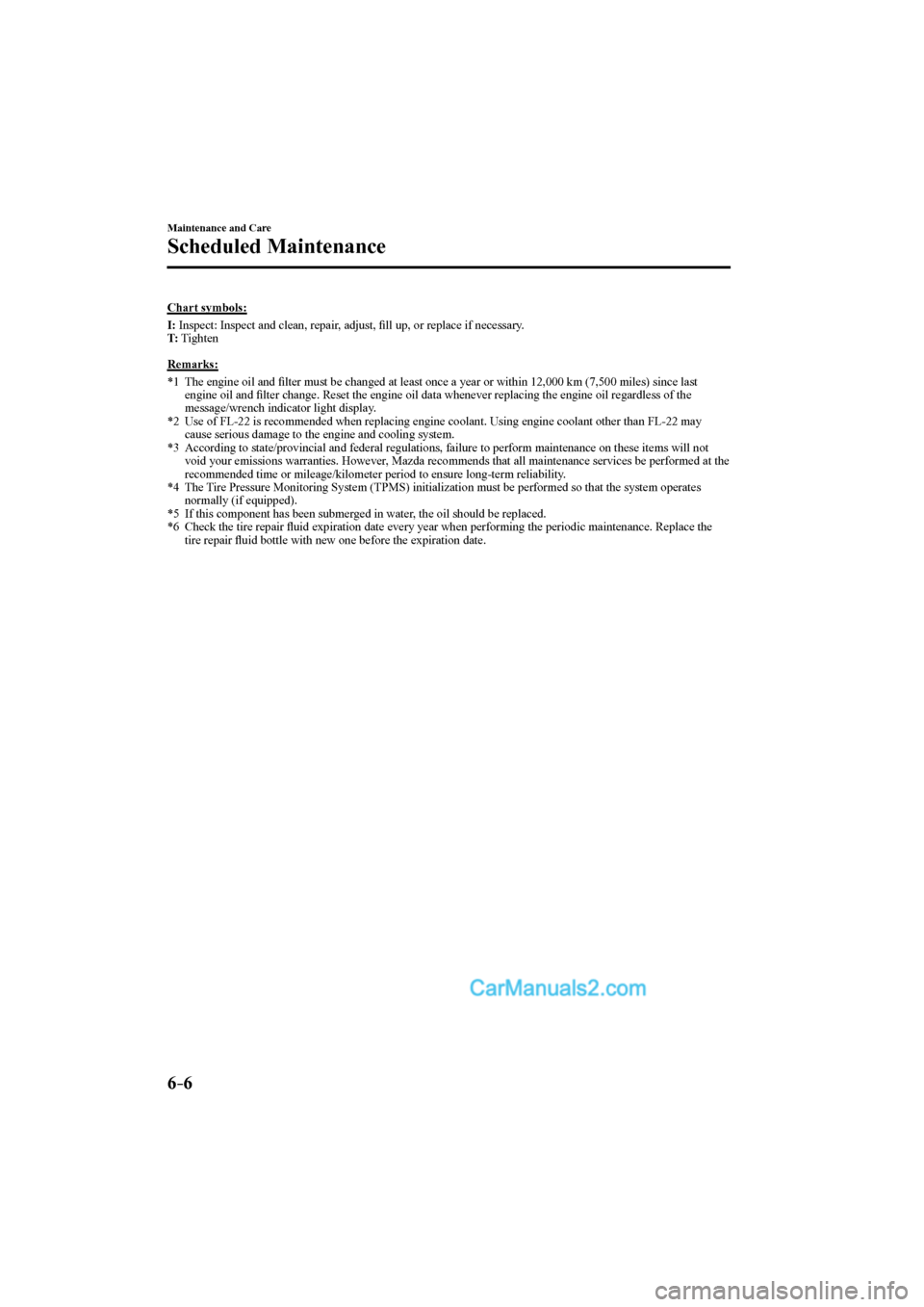
6–6
Maintenance and Care
Scheduled Maintenance
Chart symbols:
I : Inspect: Inspect and clean, repair, adjust, fi ll up, or replace if necessary.
T : Tighten
Remarks:
*1 The engine oil and fi lter must be changed at least once a year or within 12,000 km (7,500 miles) since last
engine oil and fi lter change. Reset the engine oil data whenever replacing the engine oil regardless of the
message/wrench indicator light display.
*2 Use of FL-22 is recommended when replacing engine coolant. Using engine coolant other than FL-22 may
cause serious damage to the engine and cooling system.
*3 According to state/provincial and federal regulations, failure to perform maintenance on these items will not
void your emissions warranties. However, Mazda recommends that all maintenance services be performed at the
recommended time or mileage/kilometer period to ensure long-term reliability.
*4 The Tire Pressure Monitoring System (TPMS) initialization must be performed so that the system operates
normally (if equipped).
*5 If this component has been submerged in water, the oil should be replaced.
*6 Check the tire repair fl uid expiration date every year when performing the periodic maintenance. Replace the
tire repair fl uid bottle with new one before the expiration date.
CX-9_8FS7-EA-16K_Edition2.indb 6CX-9_8FS7-EA-16K_Edition2.indb 62016/12/15 18:35:542016/12/15 18:35:54
Page 421 of 612
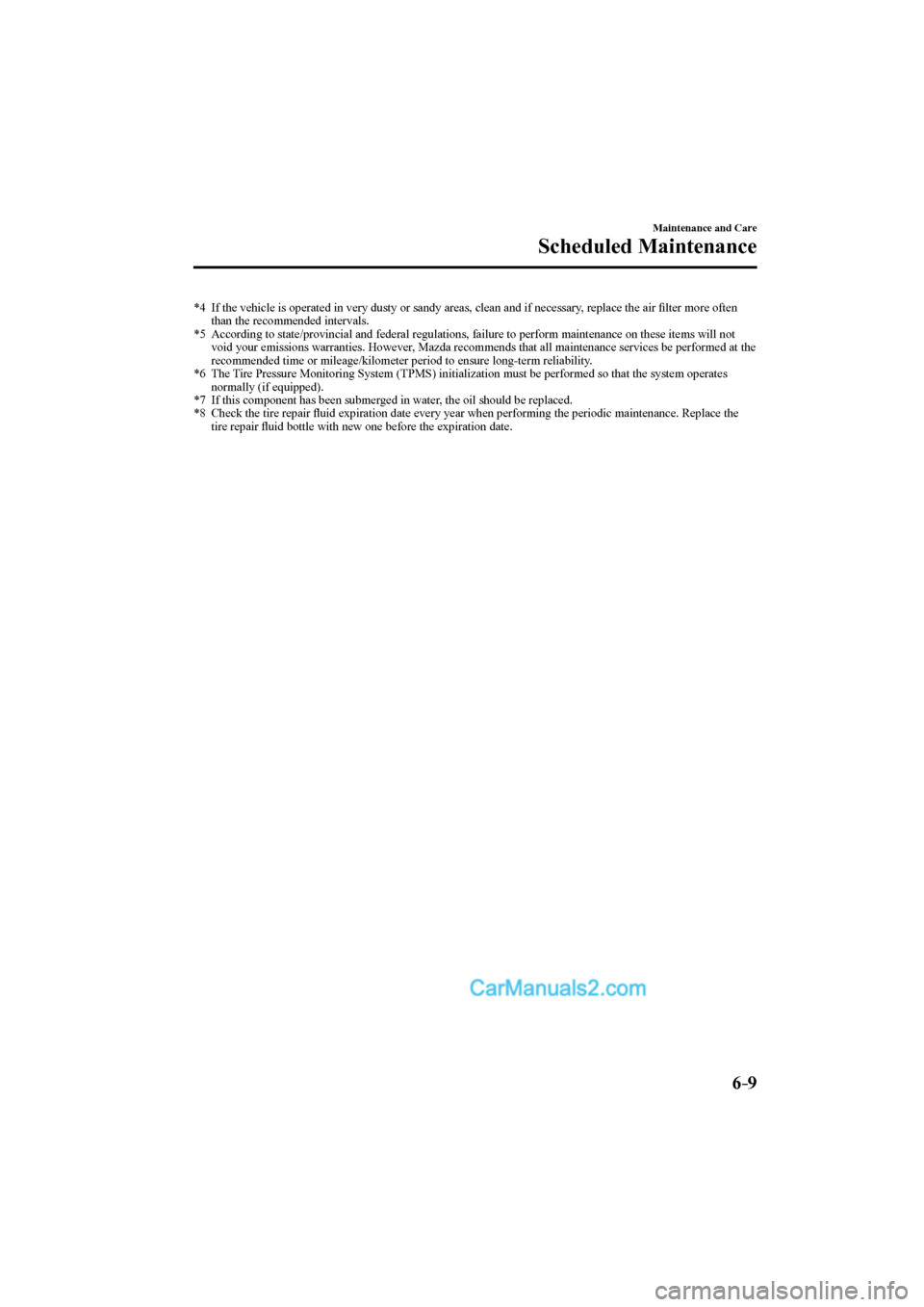
6–9
Maintenance and Care
Scheduled Maintenance
*4 If the vehicle is operated in very dusty or sandy areas, clean and if necessary, replace the air fi lter more often
than the recommended intervals.
*5 According to state/provincial and federal regulations, failure to perform maintenance on these items will not
void your emissions warranties. However, Mazda recommends that all maintenance services be performed at the
recommended time or mileage/kilometer period to ensure long-term reliability.
*6 The Tire Pressure Monitoring System (TPMS) initialization must be performed so that the system operates
normally (if equipped).
*7 If this component has been submerged in water, the oil should be replaced.
*8 Check the tire repair fl uid expiration date every year when performing the periodic maintenance. Replace the
tire repair fl uid bottle with new one before the expiration date.
CX-9_8FS7-EA-16K_Edition2.indb 9CX-9_8FS7-EA-16K_Edition2.indb 92016/12/15 18:35:552016/12/15 18:35:55
Page 423 of 612
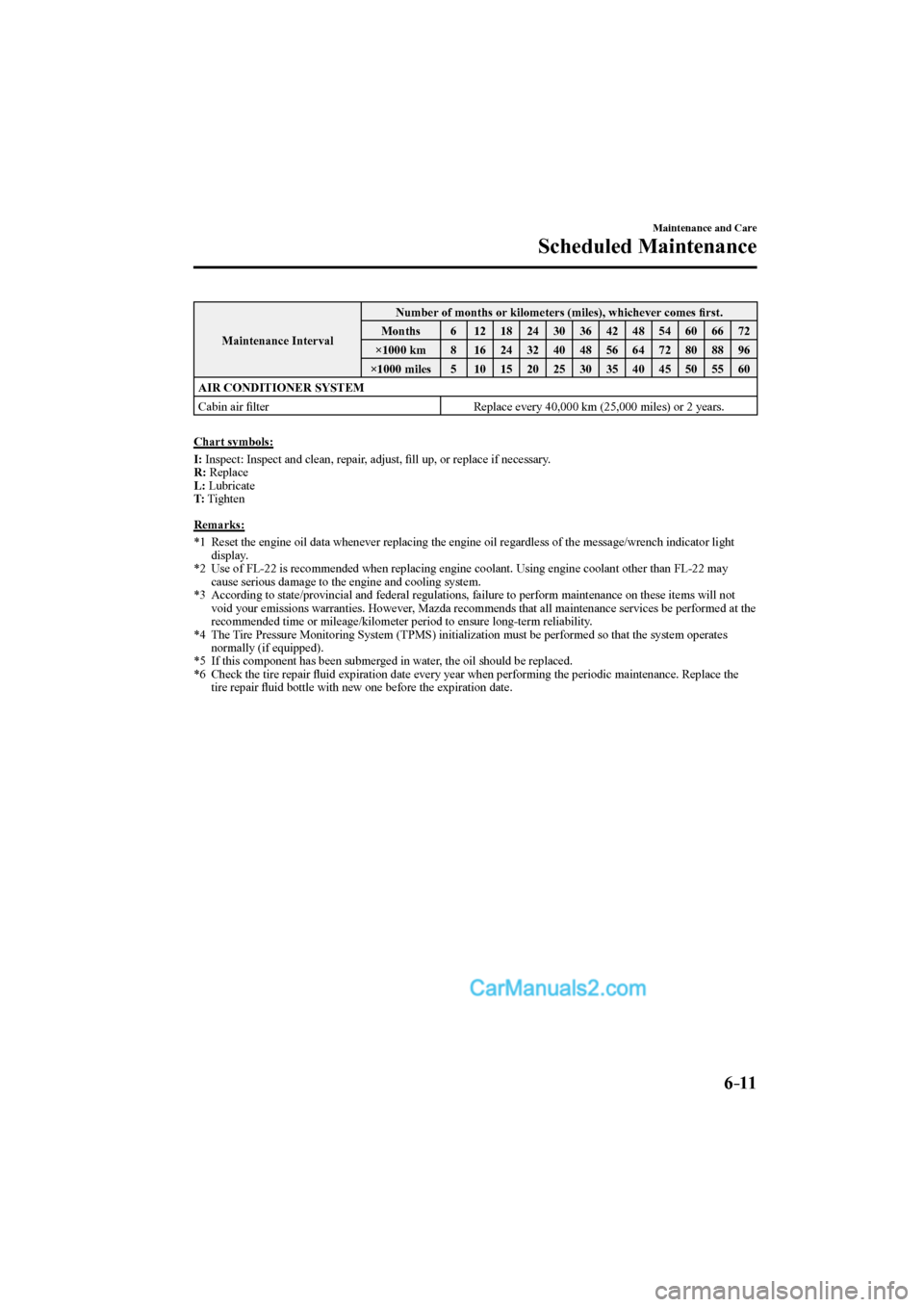
6–11
Maintenance and Care
Scheduled Maintenance
Maintenance Interval Number of months or kilometers (miles), whichever comes fi rst.
Months 6
12 18 24 30 36 42 48 54 60 66 72
×1000 km 8
16 24 32 40 48 56 64 72 80 88 96
×1000 miles 5
10 15 20 25 30 35 40 45 50 55 60
AIR CONDITIONER SYSTEM
Cabin air fi lter Replace every 40,000 km (25,000 miles) or 2 years.
Chart symbols:
I : Inspect: Inspect and clean, repair, adjust, fi ll up, or replace if necessary.
R : Replace
L : Lubricate
T : Tighten
Remarks:
*1 Reset the engine oil data whenever replacing the engine oil regardless of the message/wrench indicator light
display.
*2 Use of FL-22 is recommended when replacing engine coolant. Using engine coolant other than FL-22 may
cause serious damage to the engine and cooling system.
*3 According to state/provincial and federal regulations, failure to perform maintenance on these items will not
void your emissions warranties. However, Mazda recommends that all maintenance services be performed at the
recommended time or mileage/kilometer period to ensure long-term reliability.
*4 The Tire Pressure Monitoring System (TPMS) initialization must be performed so that the system operates
normally (if equipped).
*5 If this component has been submerged in water, the oil should be replaced.
*6 Check the tire repair fl uid expiration date every year when performing the periodic maintenance. Replace the
tire repair fl uid bottle with new one before the expiration date.
CX-9_8FS7-EA-16K_Edition2.indb 11CX-9_8FS7-EA-16K_Edition2.indb 112016/12/15 18:35:552016/12/15 18:35:55
Page 426 of 612
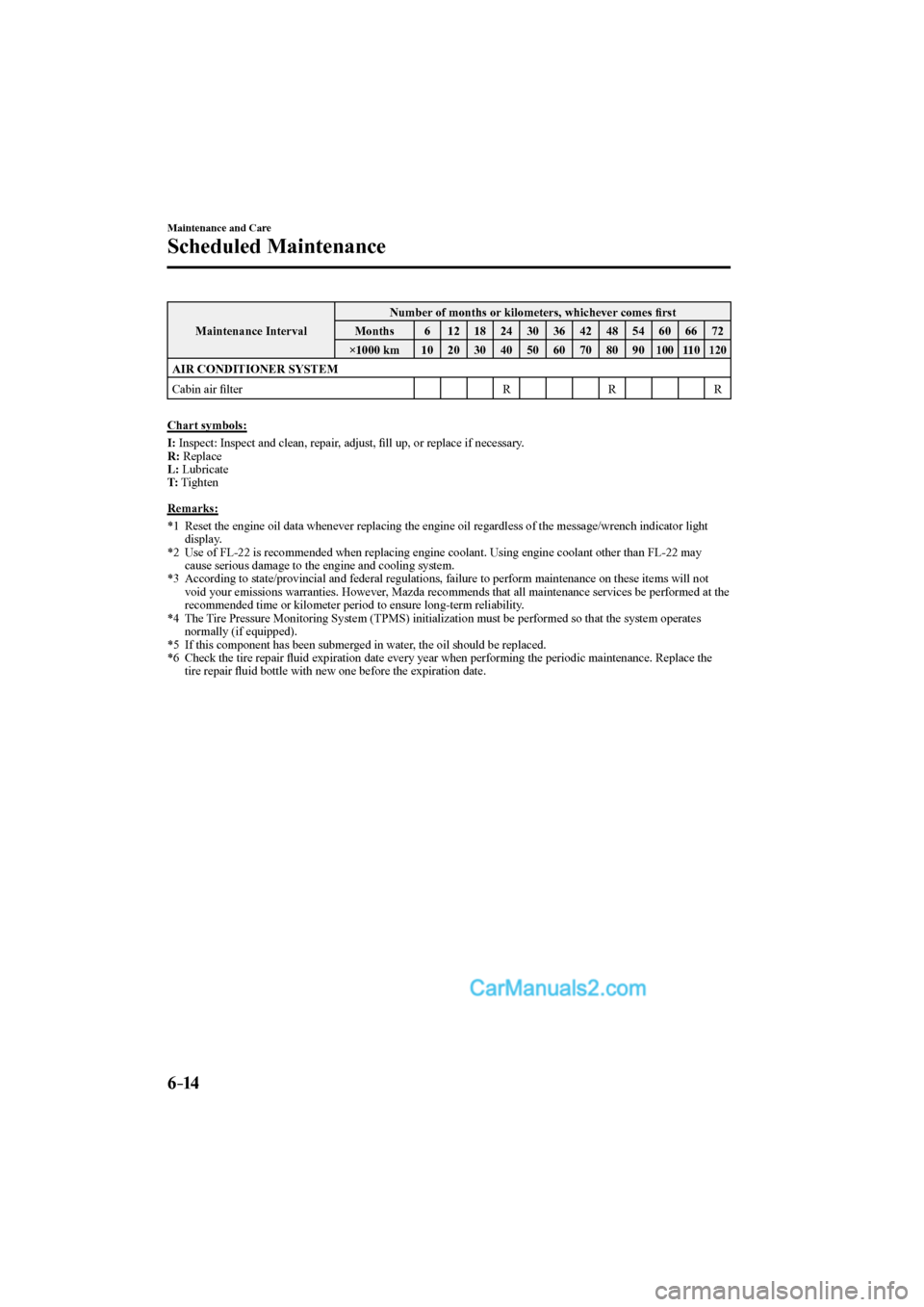
6–14
Maintenance and Care
Scheduled Maintenance
Maintenance Interval Number of months or kilometers, whichever comes fi rst
Months 6
12 18 24 30 36 42 48 54 60 66 72
×1000 km 10
20 30 40 50 60 70 80 90
100 110 120
AIR CONDITIONER SYSTEM
Cabin air fi lter R R R
Chart symbols:
I : Inspect: Inspect and clean, repair, adjust, fi ll up, or replace if necessary.
R : Replace
L : Lubricate
T : Tighten
Remarks:
*1 Reset the engine oil data whenever replacing the engine oil regardless of the message/wrench indicator light
display.
*2 Use of FL-22 is recommended when replacing engine coolant. Using engine coolant other than FL-22 may
cause serious damage to the engine and cooling system.
*3 According to state/provincial and federal regulations, failure to perform maintenance on these items will not
void your emissions warranties. However, Mazda recommends that all maintenance services be performed at the
recommended time or kilometer period to ensure long-term reliability.
*4 The Tire Pressure Monitoring System (TPMS) initialization must be performed so that the system operates
normally (if equipped).
*5 If this component has been submerged in water, the oil should be replaced.
*6 Check the tire repair fl uid expiration date every year when performing the periodic maintenance. Replace the
tire repair fl uid bottle with new one before the expiration date.
CX-9_8FS7-EA-16K_Edition2.indb 14CX-9_8FS7-EA-16K_Edition2.indb 142016/12/15 18:35:562016/12/15 18:35:56
Page 428 of 612
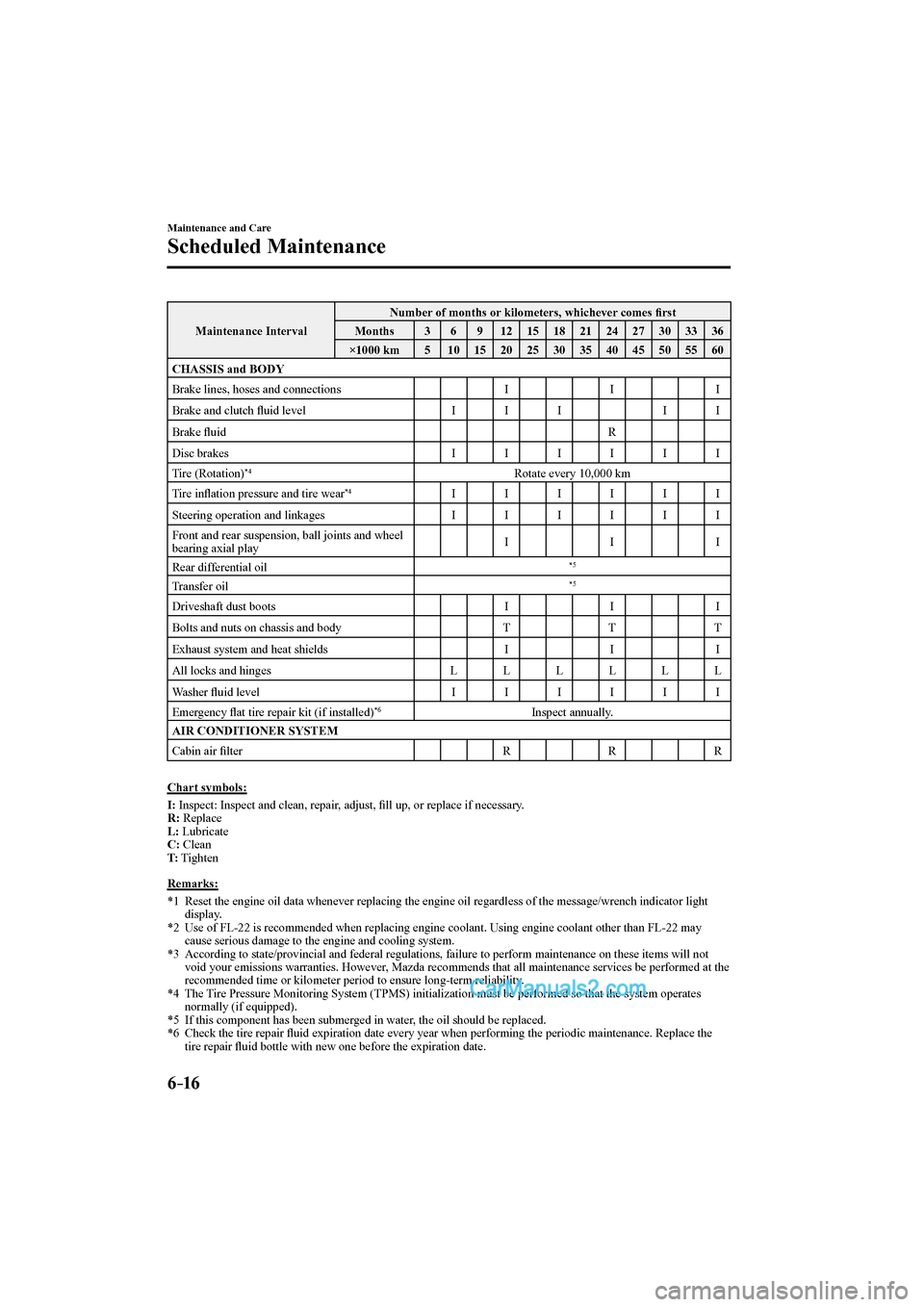
6–16
Maintenance and Care
Scheduled Maintenance
Maintenance Interval Number of months or kilometers, whichever comes fi rst
Months 3
6 9 12 15 18 21 24 27 30 33 36
×1000 km 5
10 15 20 25 30 35 40 45 50 55 60
CHASSIS and BODY
Brake lines, hoses and connections I I I
Brake and clutch fl uid level I I I I I
Brake fl uid R
Disc brakes I I I I I I
Tire (Rotation)
*4 Rotate every 10,000 km
Tire infl ation pressure and tire wear
*4 I I I I I I
Steering operation and linkages I I I I I I
Front and rear suspension, ball joints and wheel
bearing axial play I I I
Rear differential oil
*5
Transfer oil *5
Driveshaft dust boots I I I
Bolts and nuts on chassis and body T T T
Exhaust system and heat shields I I I
All locks and hinges L L L L L L
Washer fl uid level I I I I I I
Emergency fl at tire repair kit (if installed)
*6 Inspect annually.
AIR CONDITIONER SYSTEM
Cabin air fi lter R R R
Chart symbols:
I : Inspect: Inspect and clean, repair, adjust, fi ll up, or replace if necessary.
R : Replace
L : Lubricate
C : Clean
T : Tighten
Remarks:
*1 Reset the engine oil data whenever replacing the engine oil regardless of the message/wrench indicator light
display.
*2 Use of FL-22 is recommended when replacing engine coolant. Using engine coolant other than FL-22 may
cause serious damage to the engine and cooling system.
*3 According to state/provincial and federal regulations, failure to perform maintenance on these items will not
void your emissions warranties. However, Mazda recommends that all maintenance services be performed at the
recommended time or kilometer period to ensure long-term reliability.
*4 The Tire Pressure Monitoring System (TPMS) initialization must be performed so that the system operates
normally (if equipped).
*5 If this component has been submerged in water, the oil should be replaced.
*6 Check the tire repair fl uid expiration date every year when performing the periodic maintenance. Replace the
tire repair fl uid bottle with new one before the expiration date.
CX-9_8FS7-EA-16K_Edition2.indb 16CX-9_8FS7-EA-16K_Edition2.indb 162016/12/15 18:35:572016/12/15 18:35:57
Page 430 of 612
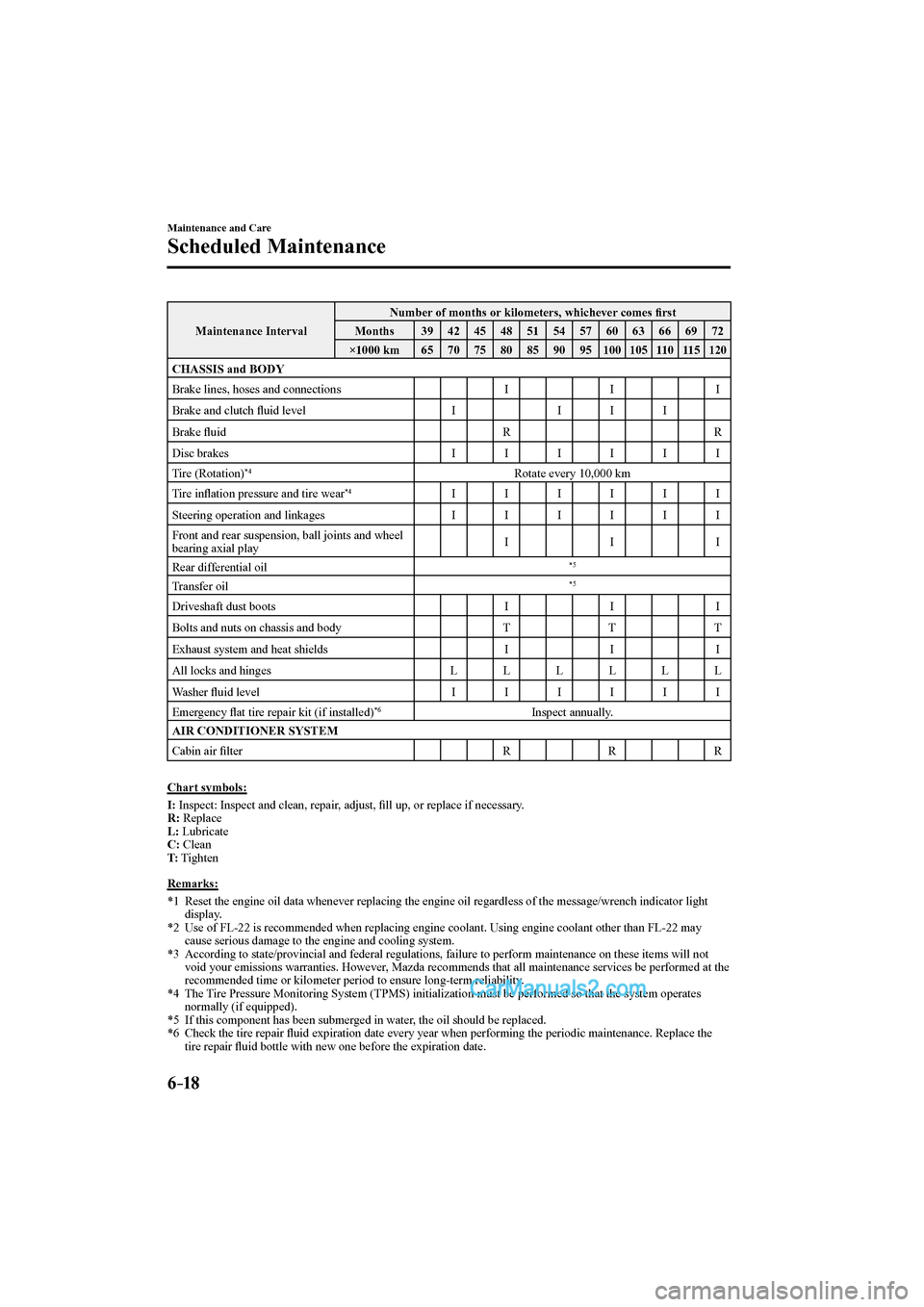
6–18
Maintenance and Care
Scheduled Maintenance
Maintenance Interval Number of months or kilometers, whichever comes fi rst
Months 39
42 45 48 51 54 57 60 63 66 69 72
×1000 km 65
70 75 80 85 90 95
100 105 110 115 120
CHASSIS and BODY
Brake lines, hoses and connections I I I
Brake and clutch fl uid level I I I I
Brake fl uid R R
Disc brakes I I I I I I
Tire (Rotation)
*4 Rotate every 10,000 km
Tire infl ation pressure and tire wear
*4 I I I I I I
Steering operation and linkages I I I I I I
Front and rear suspension, ball joints and wheel
bearing axial play I I I
Rear differential oil
*5
Transfer oil *5
Driveshaft dust boots I I I
Bolts and nuts on chassis and body T T T
Exhaust system and heat shields I I I
All locks and hinges L L L L L L
Washer fl uid level I I I I I I
Emergency fl at tire repair kit (if installed)
*6 Inspect annually.
AIR CONDITIONER SYSTEM
Cabin air fi lter R R R
Chart symbols:
I : Inspect: Inspect and clean, repair, adjust, fi ll up, or replace if necessary.
R : Replace
L : Lubricate
C : Clean
T : Tighten
Remarks:
*1 Reset the engine oil data whenever replacing the engine oil regardless of the message/wrench indicator light
display.
*2 Use of FL-22 is recommended when replacing engine coolant. Using engine coolant other than FL-22 may
cause serious damage to the engine and cooling system.
*3 According to state/provincial and federal regulations, failure to perform maintenance on these items will not
void your emissions warranties. However, Mazda recommends that all maintenance services be performed at the
recommended time or kilometer period to ensure long-term reliability.
*4 The Tire Pressure Monitoring System (TPMS) initialization must be performed so that the system operates
normally (if equipped).
*5 If this component has been submerged in water, the oil should be replaced.
*6 Check the tire repair fl uid expiration date every year when performing the periodic maintenance. Replace the
tire repair fl uid bottle with new one before the expiration date.
CX-9_8FS7-EA-16K_Edition2.indb 18CX-9_8FS7-EA-16K_Edition2.indb 182016/12/15 18:35:582016/12/15 18:35:58
Page 519 of 612
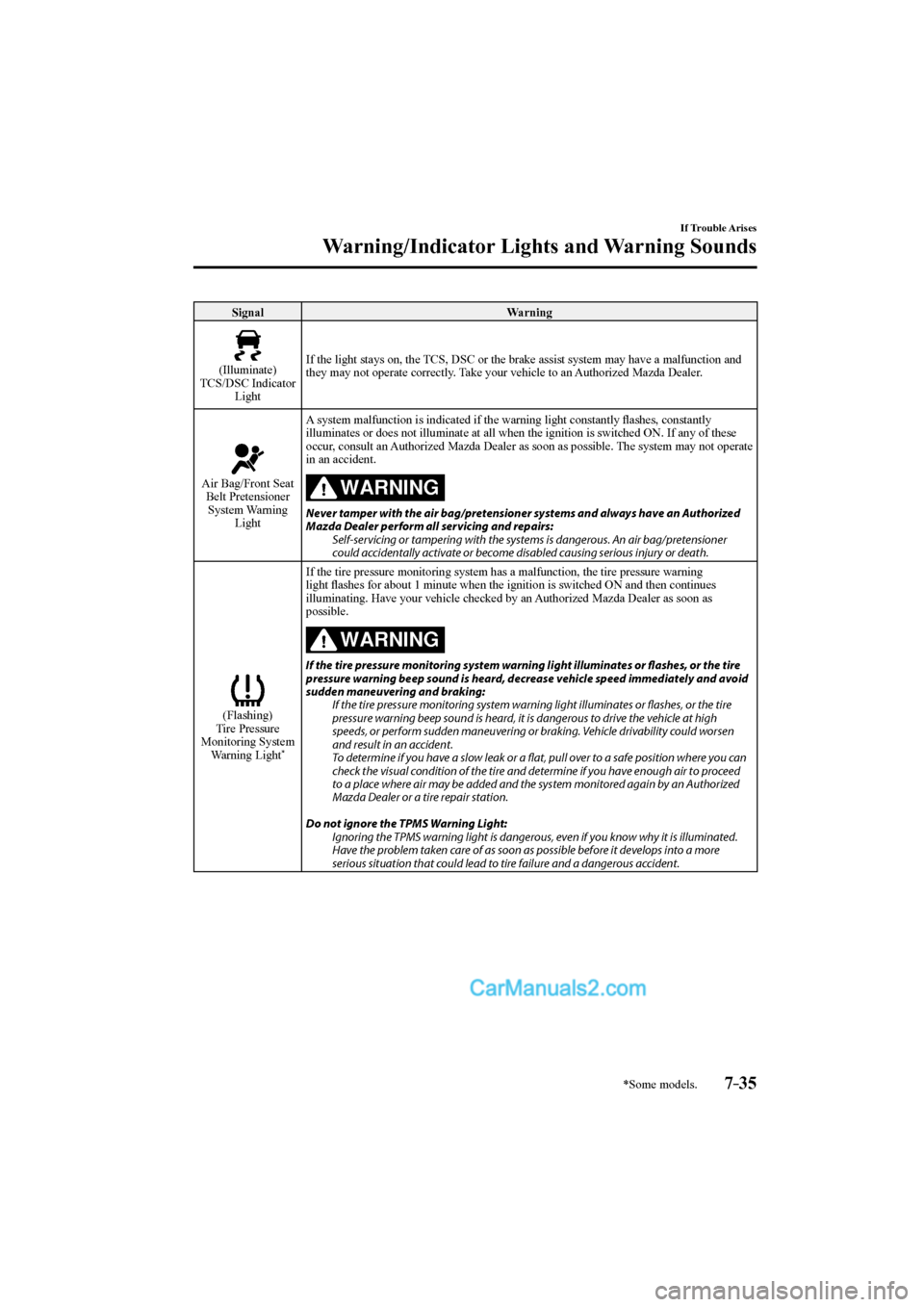
7–35
If Trouble Arises
Warning/Indicator Lights and Warning Sounds
*Some models.
Signal Warning
(Illuminate)
TCS/DSC Indicator
Light If the light stays on, the TCS, DSC or the brake assist system may have a malfunction and
they may not operate correctly. Take your vehicle to an Authorized Mazda Dealer.
Air Bag/Front Seat
Belt Pretensioner
System Warning
Light A system malfunction is indicated if the warning light constantly fl ashes, constantly
illuminates or does not illuminate at all when the ignition is switched ON. If any of these
occur, consult an Authorized Mazda Dealer as soon as possible. The system may not operate
in an accident. WARNING
Never tamper with the air bag/pretensioner systems and always have an Authorized
Mazda Dealer perform all servicing and repairs:
Self-servicing or tampering with the systems is dangerous. An air bag/pretensioner
could accidentally activate or become disabled causing serious injury or death.
(Flashing)
Tire Pressure
Monitoring System
Warning Light
* If the tire pressure monitoring system has a malfunction, the tire pressure warning
light fl ashes for about 1 minute when the ignition is switched ON and then continues
illuminating. Have your vehicle checked by an Authorized Mazda Dealer as soon as
possible.
WARNING
If the tire pressure monitoring system warning light illuminates or fl ashes, or the tire
pressure warning beep sound is heard, decrease vehicle speed immediately and avoid
sudden maneuvering and braking:
If the tire pressure monitoring system warning light illuminates or fl ashes, or the tire
pressure warning beep sound is heard, it is dangerous to drive the vehicle at high
speeds, or perform sudden maneuvering or braking. Vehicle drivability could worsen
and result in an accident.
To determine if you have a slow leak or a fl at, pull over to a safe position where you can
check the visual condition of the tire and determine if you have enough air to proceed
to a place where air may be added and the system monitored again by an Authorized
Mazda Dealer or a tire repair station.
Do not ignore the TPMS Warning Light:
Ignoring the TPMS warning light is dangerous, even if you know why it is illuminated.
Have the problem taken care of as soon as possible before it develops into a more
serious situation that could lead to tire failure and a dangerous accident.
CX-9_8FS7-EA-16K_Edition2.indb 35CX-9_8FS7-EA-16K_Edition2.indb 352016/12/15 18:36:422016/12/15 18:36:42
Page 522 of 612
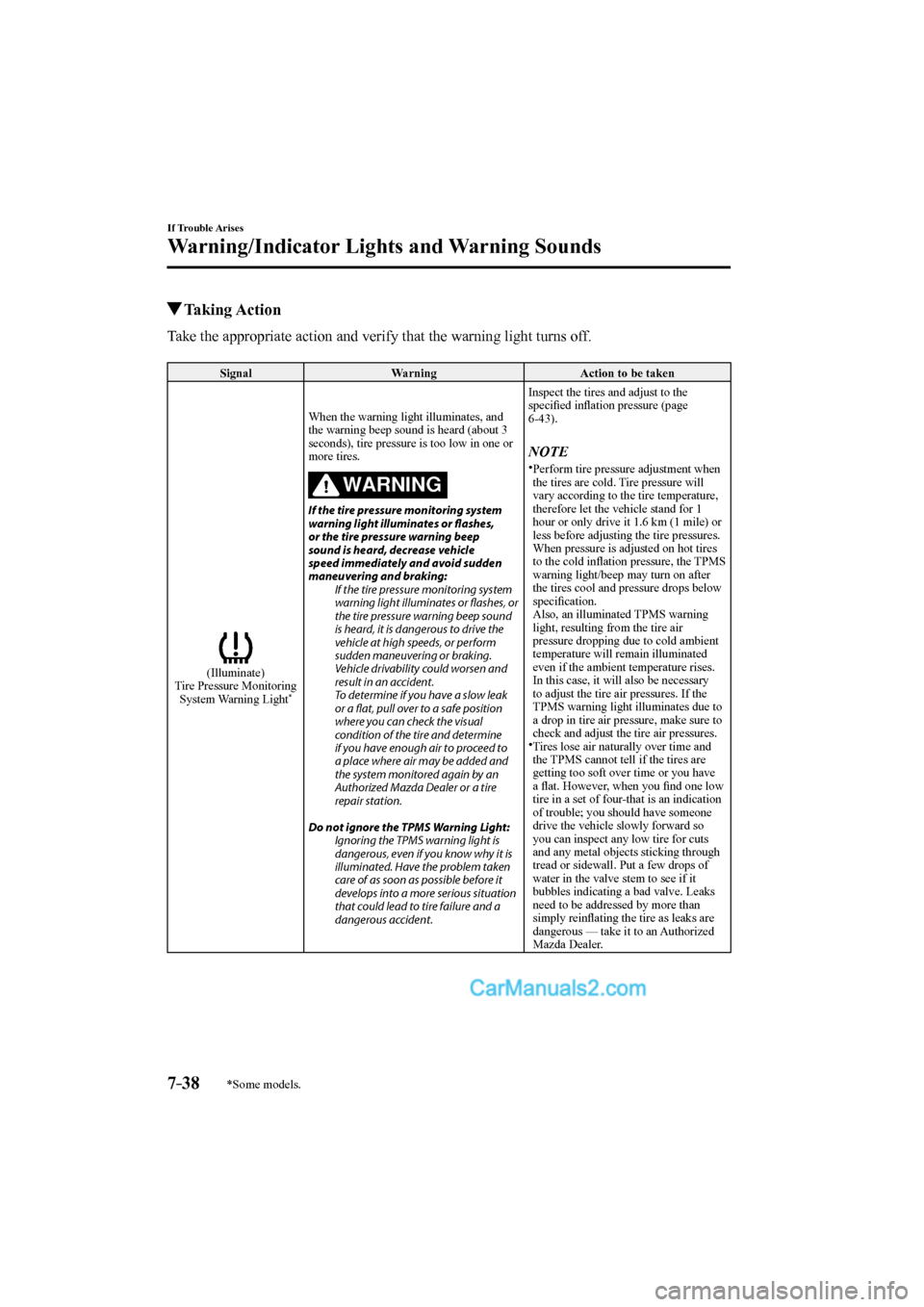
7–38
If Trouble Arises
Warning/Indicator Lights and Warning Sounds
*Some models.
Taking Action
Take the appropriate action and verify that the warning light turns off.
Signal Warning Action to be taken
(Illuminate)
Tire Pressure Monitoring
System Warning Light
* When the warning light illuminates, and
the warning beep sound is heard (about 3
seconds), tire pressure is too low in one or
more tires.
WARNING
If the tire pressure monitoring system
warning light illuminates or fl ashes,
or the tire pressure warning beep
sound is heard, decrease vehicle
speed immediately and avoid sudden
maneuvering and braking:
If the tire pressure monitoring system
warning light illuminates or fl ashes, or
the tire pressure warning beep sound
is heard, it is dangerous to drive the
vehicle at high speeds, or perform
sudden maneuvering or braking.
Vehicle drivability could worsen and
result in an accident.
To determine if you have a slow leak
or a fl at, pull over to a safe position
where you can check the visual
condition of the tire and determine
if you have enough air to proceed to
a place where air may be added and
the system monitored again by an
Authorized Mazda Dealer or a tire
repair station.
Do not ignore the TPMS Warning Light:
Ignoring the TPMS warning light is
dangerous, even if you know why it is
illuminated. Have the problem taken
care of as soon as possible before it
develops into a more serious situation
that could lead to tire failure and a
dangerous accident. Inspect the tires and adjust to the
specifi ed infl ation pressure (page
6-43 ).
NOTE
Perform tire pressure adjustment when
the tires are cold. Tire pressure will
vary according to the tire temperature,
therefore let the vehicle stand for 1
hour or only drive it 1.6 km (1 mile) or
less before adjusting the tire pressures.
When pressure is adjusted on hot tires
to the cold infl ation pressure, the TPMS
warning light/beep may turn on after
the tires cool and pressure drops below
specifi cation.
Also, an illuminated TPMS warning
light, resulting from the tire air
pressure dropping due to cold ambient
temperature will remain illuminated
even if the ambient temperature rises.
In this case, it will also be necessary
to adjust the tire air pressures. If the
TPMS warning light illuminates due to
a drop in tire air pressure, make sure to
check and adjust the tire air pressures.
Tires lose air naturally over time and
the TPMS cannot tell if the tires are
getting too soft over time or you have
a fl at. However, when you fi nd one low
tire in a set of four-that is an indication
of trouble; you should have someone
drive the vehicle slowly forward so
you can inspect any low tire for cuts
and any metal objects sticking through
tread or sidewall. Put a few drops of
water in the valve stem to see if it
bubbles indicating a bad valve. Leaks
need to be addressed by more than
simply reinfl ating the tire as leaks are
dangerous — take it to an Authorized
Mazda Dealer.
CX-9_8FS7-EA-16K_Edition2.indb 38CX-9_8FS7-EA-16K_Edition2.indb 382016/12/15 18:36:442016/12/15 18:36:44